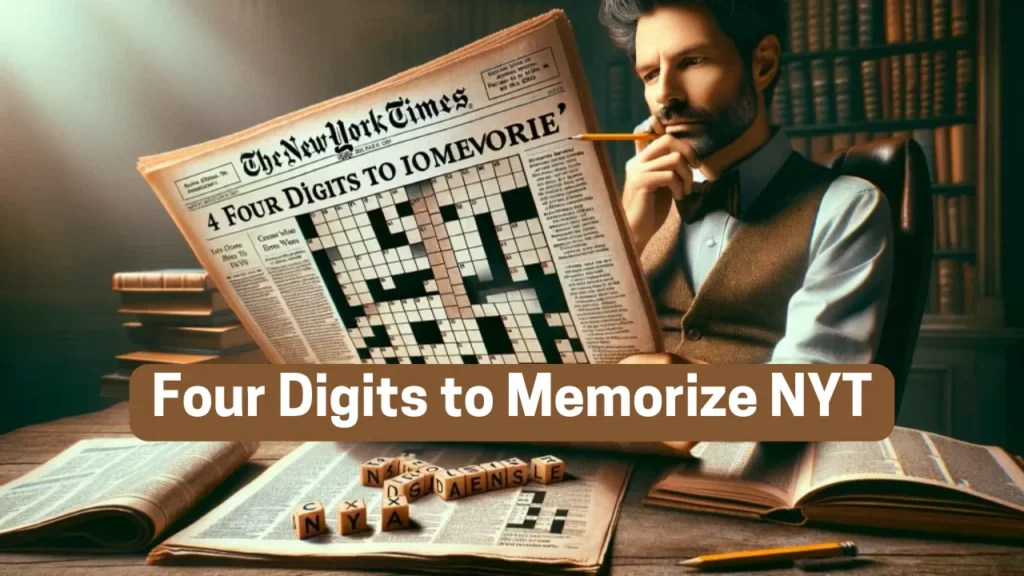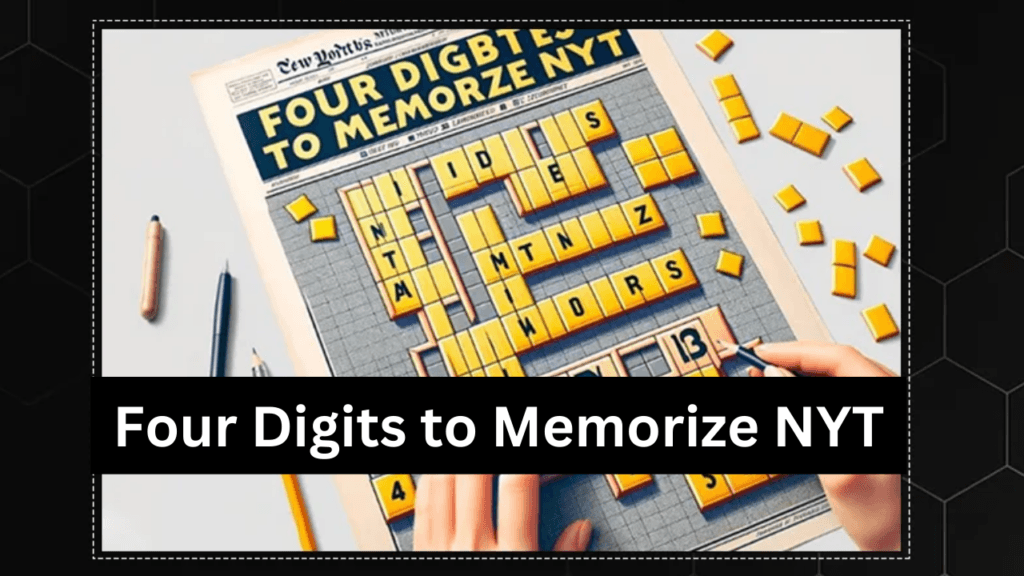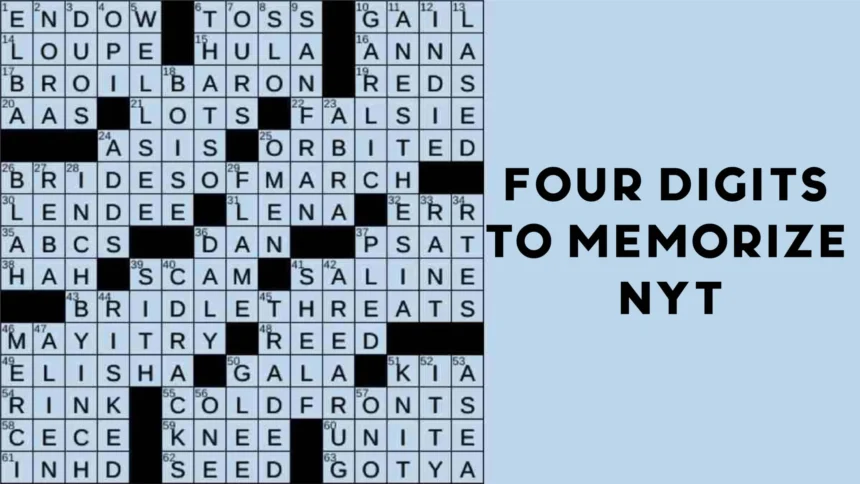Introduction to the NYT Crossword
The New York Times Crossword is more than just a puzzle; it’s a cultural phenomenon. For decades, it has been a daily ritual for millions, challenging their minds and expanding their vocabularies. But what is it about the NYT Crossword that makes it so unique? One factor is the cleverness of its clues, including those that leave even the most seasoned solvers scratching their heads—like the enigmatic “four digits to memorize nyt” clue.
Understanding the “Four Digits to Memorize” Clue
What the Clue Means
When you come across a clue like “four digits to memorize,” it might seem straightforward, but it’s anything but. This clue requires solvers to think beyond the obvious, often leading to an “aha” moment when the answer finally clicks. The answer typically involves a common number or sequence that has become significant in some context—be it cultural, historical, or even mathematical.
How It Fits into the Crossword Puzzle
Such clues are designed to blend seamlessly into the overall theme of the puzzle. They might tie into other clues, creating a cohesive narrative within the grid. The beauty of the NYT Crossword lies in how it makes you connect the dots, and numeric clues like this one are no exception.
Historical Significance of the Clue
The “four digits to memorize” clue has appeared in various forms throughout the history of the NYT Crossword, each time testing the solver’s ability to recall or deduce a sequence of numbers that holds significance. Whether it’s a year, a PIN, or a famous number from literature or pop culture, these clues have left a mark on the crossword-solving community.
Common Interpretations of the Clue
Popular Answers Over the Years
Over the years, this clue has pointed to answers ranging from important years in history (like 1776) to widely recognized numbers in everyday life (such as 911). The context of the puzzle often provides hints, but it’s the solver’s knowledge and intuition that lead to the correct answer.
How Solvers Approach Such Clues
Experienced solvers approach numeric clues with a combination of logic and creativity. They consider the puzzle’s theme, cross-referenced clues, and any partial answers they’ve already filled in. This methodical approach often leads to that satisfying moment when the digits fall into place.
Tricks and Tips for Interpreting Digit-Based Clues
One effective strategy is to think about numbers that are commonly referenced in various contexts. Additionally, considering the length of the answer and the letters provided by intersecting words can help narrow down the possibilities.

The Role of Numbers in Crossword Puzzles
Why Numbers Are Used in Crosswords
Numbers add an extra layer of complexity to crosswords. Unlike words, which have synonyms and multiple meanings, numbers are fixed, which makes them both challenging and rewarding to solve. They often require solvers to think outside the box and consider non-verbal information.
Examples of Other Number-Based Clues
Besides “four digits to memorize,” crosswords frequently feature other number-based clues. For example, “atomic number of gold” would lead to 79, or “year of the Magna Carta” might point to 1215. These clues rely on the solver’s factual knowledge rather than linguistic prowess.
The Challenge of Numeric Answers
Numeric answers can be particularly tricky because they don’t follow the same rules as word-based clues. There’s no room for interpretation or guesswork; you either know the number, or you don’t. This makes solving them a test of both memory and logic.
Solving Techniques for Numeric Clues
Pattern Recognition
Recognizing patterns is a key skill in solving numeric clues. Whether it’s a familiar sequence or a number associated with a specific event, identifying the pattern can lead directly to the answer.
Using the Process of Elimination
When faced with multiple possibilities, the process of elimination can be a lifesaver. By ruling out numbers that don’t fit the clue or the intersecting words, solvers can narrow down their options until only the correct answer remains.
Leveraging Crossword Puzzle Themes
Often, the theme of the puzzle provides a significant hint. For instance, if the puzzle’s theme is “U.S. History,” the four digits are likely a year of historical importance. Paying attention to the theme can guide you to the right answer more quickly.
Memorable “Four Digits to Memorize NYT” Clues
Famous Instances in NYT Crossword History
One of the most famous “four digits to memorize” clues led to the answer “1984,” referencing George Orwell’s dystopian novel. Another memorable instance involved the digit “0070,” a nod to the famous James Bond agent number.
How These Clues Have Evolved
Over the years, these clues have become more creative and subtle. Early crosswords might have straightforwardly referenced a year or a familiar number, but modern puzzles often incorporate more obscure or cleverly disguised numeric sequences.
The Impact of Such Clues on Puzzle Difficulty
These clues often serve as the linchpin of the puzzle, with the difficulty of the entire crossword hinging on the solver’s ability to crack them. Successfully solving one of these can be a major confidence booster, making the rest of the puzzle feel more approachable.

The Psychology of Memorization in Crossword Puzzles
Why We Remember Certain Clues
Certain clues stick in our memory because they resonate with something personal or significant. A clue that recalls a pivotal moment in history or a beloved piece of literature is more likely to be remembered and recognized when it reappears in future puzzles.
The Connection Between Memorization and Puzzle-Solving
Memorization plays a crucial role in solving crosswords, particularly with clues that recur in different forms. The more puzzles you solve, the more familiar you become with common numeric clues, making them easier to spot and solve over time.
How to Improve Your Memorization Skills for Puzzles
Improving your memory for crosswords involves practice and exposure. The more you engage with puzzles, the better you’ll become at recalling previously encountered clues. Keeping a crossword journal where you note down tricky or interesting clues can also be helpful.
Frequently Confusing Digits in Crosswords
Commonly Mistaken Numbers
Some numbers are prone to be confused, such as years that are close together (e.g., 1775 vs. 1776) or numbers with similar patterns (e.g., 1234 vs. 4321). Being aware of these common pitfalls can help prevent errors.
Strategies to Avoid Confusion
To avoid confusion, it’s important to double-check your answers against the clue and the intersecting words. If a number seems off, revisit the clue to ensure you haven’t misinterpreted it.
How to Double-Check Your Answers
Double-checking involves reviewing the puzzle for any inconsistencies. If a number doesn’t fit logically with the surrounding words, it’s worth reconsidering your interpretation of the clue.
The Influence of Culture on Numeric Clues
How Cultural References Shape Crossword Clues
Cultural references heavily influence crossword clues, and numeric clues are no exception. A clue like “four digits to memorize” might reference a year of a significant cultural event or a number ingrained in pop culture.
The Role of Historical Events in Numeric Clues
Historical events provide a rich source of material for numeric clues. Whether it’s a year of a significant battle or the signing of a crucial document, these clues often test the solver’s knowledge of history.
Why Certain Digits Become Iconic
Certain digits become iconic because they are repeatedly referenced in media, literature, and everyday life. Numbers like “911” or “007” have transcended their original meanings to become symbols of broader concepts.
Solving the “Four Digits to Memorize” Clue
A Step-by-Step Guide
- Read the Clue Carefully: Understand the context and any potential hints in the surrounding clues.
- Consider the Puzzle’s Theme: Use the theme to narrow down the possibilities.
- Check the Length and Crosses: Ensure the number fits with the intersecting words.
- Think About Common Numbers: Consider frequently used numbers or significant dates.
- Fill It In Once you’re confident, fill in the digits and move on to the next clue.
Tools and Resources to Assist with Solving
There are several tools available for crossword enthusiasts, including online databases that allow you to search for clues by keywords or patterns. Apps like Crossword Solver can also help by providing possible answers based on the letters you have.
What to Do If You’re Stuck
If you’re stuck, take a break and come back to the puzzle later. Fresh eyes can often see things you missed before. If you’re still having trouble, consider using a crossword hint tool, but only as a last resort.

Advanced Techniques for Expert Solvers
How Pros Tackle Digit-Based Clues
Expert solvers often rely on their extensive knowledge of past puzzles and common numeric clues. They may also use advanced techniques like pattern recognition or lateral thinking to solve particularly challenging clues.
The Importance of Crossword Databases
Crossword databases can be invaluable resources, allowing solvers to search for specific clues or review past puzzles. These databases often include a wealth of information on how certain clues have been used historically.
Using AI to Enhance Your Solving Skills
AI tools are becoming increasingly popular among crossword enthusiasts. These tools can analyze patterns, suggest possible answers, and even offer hints on difficult clues, making them a valuable resource for solvers of all levels.
The Future of Crossword Clues
Trends in Crossword Puzzle Creation
As crossword puzzles continue to evolve, we can expect to see more innovative and complex clues, including numeric ones. Puzzle creators are constantly pushing the boundaries, finding new ways to challenge and engage solvers.
How Clues Are Becoming More Complex
Modern crossword clues are increasingly intricate, often requiring solvers to draw on a wide range of knowledge. Numeric clues are no exception, with many now incorporating multiple layers of meaning.
The Role of Technology in Modern Puzzles
Technology is playing a larger role in both the creation and solving of crossword puzzles. From AI-assisted puzzle generation to online solving tools, technology is making crosswords more accessible and engaging than ever before.
Conclusion
The “four digits to memorize nyt” clue is a quintessential example of what makes the NYT Crossword both challenging and rewarding. It’s a clue that requires not just knowledge, but creativity and persistence. As crossword puzzles continue to evolve, so too will the clues, offering solvers new challenges to conquer. Whether you’re a novice or a seasoned pro, mastering clues like these is a key part of becoming a better solver.
Frequently Asked Questions
What is the “Four Digits to Memorize” clue in the NYT Crossword?
The “Four Digits to Memorize” clue typically refers to a significant number or sequence of numbers that solvers are expected to recall or deduce based on the puzzle’s theme and other clues.
Why are numeric clues challenging in crosswords?
Numeric clues are challenging because they don’t allow for as much flexibility as word-based clues. You either know the number or you don’t, which can make these clues particularly tough to crack.
How can I improve my crossword-solving skills?
Practice is key to improving your crossword-solving skills. Additionally, familiarizing yourself with common clues, keeping a crossword journal, and using online resources can help you become a better solver.
What resources are available for crossword enthusiasts?
There are many resources available for crossword enthusiasts, including online databases, apps like Crossword Solver, and AI tools that can provide hints and suggestions.
Are there any apps that help with solving crossword puzzles?
Yes, there are several apps designed to assist with crossword puzzles, such as Crossword Solver, which can help you find possible answers based on the letters you have.










